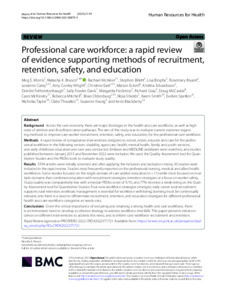MORRIS, Meg E., BRUSCO, Natasha K., MCALEER, Rachael, BILLETT, Stephen, BROPHY, Lisa, BRYANT, Rosemary, CAREY, Leeanne, WRIGHT, Amy Conley, EAST, Christine, ECKERT, Marion, EDVARDSSON, Kristina, FETHERSTONHAUGH, Deirdre, FOWLER-DAVIS, Sally, FREDERICO, Margarita, GRAY, Richard, MCCASKIE, Doug, MCKINSTRY, Carol, MITCHELL, Rebecca, OLDENBURG, Brian, SHIELDS, Nora, SMITH, Karen, SPELTEN, Evelien, TAYLOR, Nicholas, THWAITES, Claire, YOUNG, Suzanne and BLACKBERRY, Irene
(2023).
Professional care workforce: a rapid review of evidence supporting methods of recruitment, retention, safety, and education.
Human Resources for Health, 21 (1): 95.
[Article]
Documents
32883:628428
![[thumbnail of 12960_2023_Article_879.pdf]](https://shura.shu.ac.uk/32883/1.hassmallThumbnailVersion/12960_2023_Article_879.pdf)

Preview
Abstract
Background: Across the care economy there are major shortages in the health and care workforce, as well as high rates of attrition and ill-defined career pathways. The aim of this study was to evaluate current evidence regarding methods to improve care worker recruitment, retention, safety, and education, for the professional care workforce. Methods: A rapid review of comparative interventions designed to recruit, retain, educate and care for the professional workforce in the following sectors: disability, aged care, health, mental health, family and youth services, and early childhood education and care was conducted. Embase and MEDLINE databases were searched, and studies published between January 2015 and November 2022 were included. We used the Quality Assessment tool for Quantitative Studies and the PEDro tools to evaluate study quality. Results: 5594 articles were initially screened and after applying the inclusion and exclusion criteria, 30 studies were included in the rapid review. Studies most frequently reported on the professional nursing, medical and allied health workforces. Some studies focused on the single domain of care worker education (n = 11) while most focused on multiple domains that combined education with recruitment strategies, retention strategies or a focus on worker safety. Study quality was comparatively low with a median PEDro score of 5/10, and 77% received a weak rating on the Quality Assessment tool for Quantitative Studies. Four new workforce strategies emerged; early career rural recruitment supports rural retention; workload management is essential for workforce well-being; learning must be contextually relevant; and there is a need to differentiate recruitment, retention, and education strategies for different professional health and care workforce categories as needs vary. Conclusions: Given the critical importance of recruiting and retaining a strong health and care workforce, there is an immediate need to develop a cohesive strategy to address workforce shortfalls. This paper presents initial evidence on different interventions to address this need, and to inform care workforce recruitment and retention. Rapid Review registration PROSPERO 2022 CRD42022371721 Available from: https://www.crd.york.ac.uk/prospero/display_record.php?ID=CRD42022371721
Actions (login required)
 |
View Item |



 Tools
Tools Tools
Tools